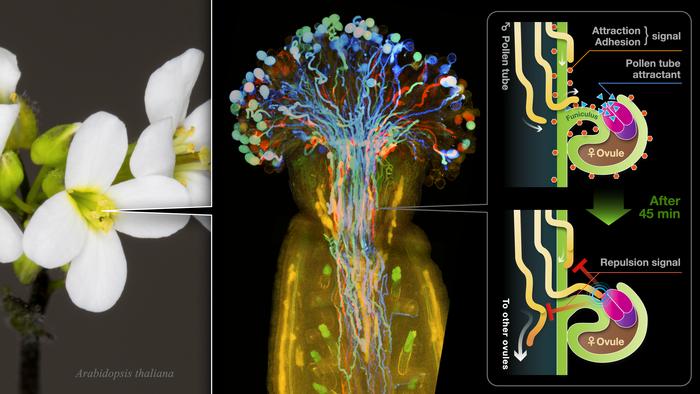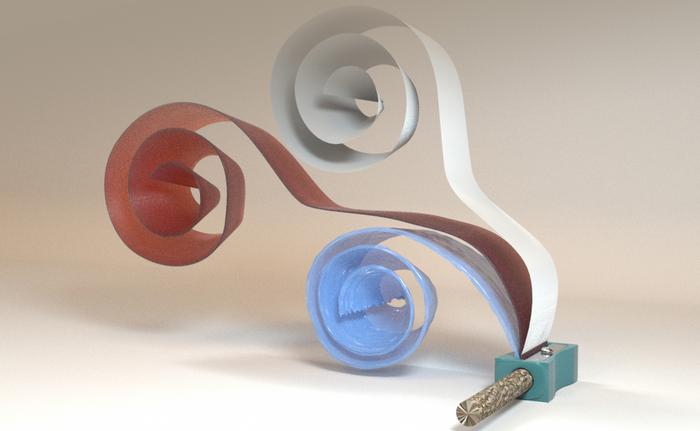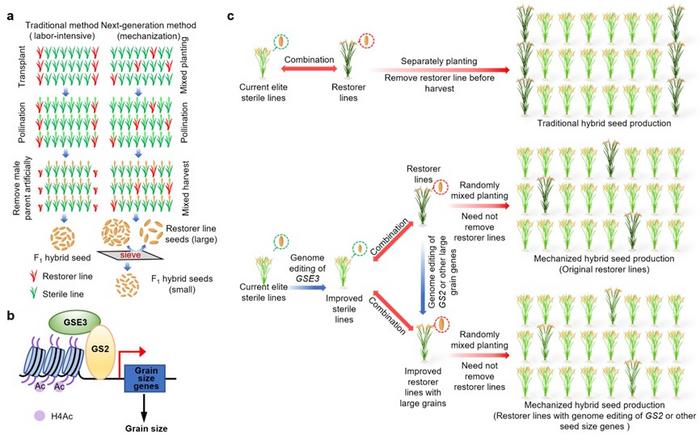A group of scientists from Nagoya University in Japan has used a specialized microscopic technique to observe the internal reproduction process of the Arabidopsis plant. Their findings, published in EMBO Reports, reveal the mechanism behind a female flower selectively attracting a single male counterpart. These findings provide insights that may help optimize seed production and improve agricultural breeding practices.

Angiosperms, commonly referred to as flowering plants, have male and female reproductive organs. In the process of plant reproduction, when a pollen grain that transports male gametes lands on the stigma of another flower, it initiates the formation of a pollen tube. The tube extends through the style and into the ovary, allowing sperm cells to reach the egg and central cells in an ovule for fertilization.
To better understand this process, the researchers created a unique microscopic technique using a two-photon microscope. According to the lead author, Yoko Mizuta, the three-year effort was like a journey. “It involved delicate sample handling techniques and optimization of conditions, such as excitation wavelengths, for achieving deep imaging of flowers,” she explained.
Sign up for the Daily Dose Newsletter and get every morning’s best science news from around the web delivered straight to your inbox? It’s easy like Sunday morning.
Using their technique, the team was able to observe, for the first time, the elongation of multiple pollen tubes within a living pistil and their unique attraction to female tissue. This allowed them to identify a signal emitted by the maternal tissue that attracts pollen tubes by leading them to elongate along the stamen tissue and reach the site of fertilization. This is the signal that enables the precise management of one-to-one pollen tube guidance.
One-to-one pollen tube guidance is a critical process in plant reproduction that involves precise navigation of pollen tubes to individual ovules. This mechanism ensures the successful fertilization of angiosperms by facilitating the specific coupling between ovules and individual pollen tubes.
In addition to the signal that promotes attraction between individuals, Mizuta and her colleagues were also surprised to find a repulsion signal. This signal was emitted upon attracting a pollen tube, discouraging the further attraction of additional pollen tubes. In addition to the 45-minute blocking process that prevents multiple sperm from fertilizing the same ovule, a repulsion signal also directs rejected suitors towards other unpaired ovules.
“I find the repulsion system fascinating,” Mizuta said. “The cells that generate the attraction system are mostly synergid cells, whereas the cells that generate the repulsion system include multiple types such as somatic and gametophytic cells at multistep levels. I find it very interesting that all couplings involve this mechanism of attracting and repelling.”
Further analysis showed the complexity of the one-to-one pollen tube guidance process, revealing anintricate regulatory mechanism that requires the involvement of various cells in both male and female plants. This precise regulation ensures successful fertilization and efficient seed production, particularly under challenging environmental conditions.
Mizuta emphasized the importance of this mechanism in maximizing seed production. “By precisely orchestrating the behavior of pollen tubes, plants have evolved a mechanism to ensure successful fertilization and efficient seed production on dry land with a limited number of suitors,” she remarked.
This research provides valuable information about how plants reproduce and has the potential to benefit agricultural breeding by increasing seed production and improving germination rates.
IMAGE CREDIT: Issey Takahashi
If you enjoy the content we create and would like to support us, please consider becoming a patron on Patreon! By joining our community, you’ll gain access to exclusive perks such as early access to our latest content, behind-the-scenes updates, and the ability to submit questions and suggest topics for us to cover. Your support will enable us to continue creating high-quality content and reach a wider audience.
Join us on Patreon today and let’s work together to create more amazing content! https://www.patreon.com/ScientificInquirer


.jpg)


Leave a Reply